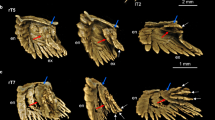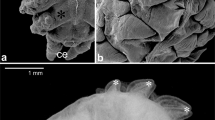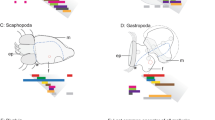Abstract
The evidence for the theory that Amphioxus is “essentially a pædomorphic transformation of a sessile Protascidian” is even stronger to-day than when Garstang1 first proposed it. The more recent of Conklin's investigations2 have shown the early development of Amphioxus to be “more strikingly like that of Ascidians than has been recognized hitherto”, and the fate-map of Amphioxus is very closely similar to that of Ascidiella3. One apparent anomaly—that the egg of Amphioxus, unlike the ascidian's, is still of the ‘regulation’ type after its first cleavage2—yields to Berrill's quantitative proof4 of the relative retardation of the development of Amphioxus, and the absence of a larval enterocœle and segmented mesoderm in Ascidians may perhaps do so too. But there remains one notorious obstacle to attempts to bring the two forms more closely into line: the grotesque asymmetry of the Amphioxus larva. Half a dozen theories have therefore been devised to explain it away as a larval adaptation of secondary import; but none has been proposed with much conviction or generally agreed upon. The interpretation to be set out here, so far from alienating Amphioxus from the ascidian, argues for an even closer affinity between them than is generally admitted.
This is a preview of subscription content, access via your institution
Access options
Subscribe to this journal
Receive 51 print issues and online access
$199.00 per year
only $3.90 per issue
Buy this article
- Purchase on Springer Link
- Instant access to full article PDF
Prices may be subject to local taxes which are calculated during checkout
Similar content being viewed by others
References
Garstang, W., Quart. J. Mic. Sci., 72, 51 (1928).
Conklin, E. G., J. Morph., 54, 69 (1932); J. Exp. Zool., 64, 303 (1933).
Vandebroek, G. (unpublished). See Dalcq, A., “Form and Causality in Early Development”, 37 (Cambridge, 1938).
Berrill, N. J., “Essays on Growth and Form” (Oxford, 1945).
Willey, A., “Amphioxus and the Ancestry of Vertebrates” (London, 1894).
Berrill, N. J., J. Morph., 81, 262 (1947).
Orton, J. H., J. Mar. Biol. Assoc. U.K., 10, 506 (1914).
van Wijhe, J. W., Proc. Section of Sciences, Kon. Akad. Wet. Amsterdam, 29, 286 (1926); 30, 991 (1927). (van Wijhe was unaware of Orton's work when he reported on the fixation of larval Amphioxus).
Mr. H. K. Pusey, who has given me the most valuable criticism in the preparation of the paper, suggests that the dorsal mouth and anterior endostyle may also be ‘forward looking’ characters in just this sense. In Ascidians, as in Amphioxus, the mouth rudiment first appears in an antero-ventral position.
Orton, J. H., J. Mar. Biol. Assoc. U.K., 10, 19 (1913).
Author information
Authors and Affiliations
Rights and permissions
About this article
Cite this article
MEDAWAR, P. Asymmetry of Larval Amphioxus. Nature 167, 852–853 (1951). https://doi.org/10.1038/167852a0
Issue Date:
DOI: https://doi.org/10.1038/167852a0
This article is cited by
-
Hedgehog signaling controls mouth opening in the amphioxus
Zoological Letters (2021)
-
Amphioxus mouth after dorso-ventral inversion
Zoological Letters (2016)
Comments
By submitting a comment you agree to abide by our Terms and Community Guidelines. If you find something abusive or that does not comply with our terms or guidelines please flag it as inappropriate.



